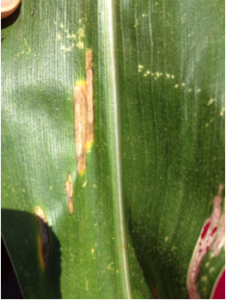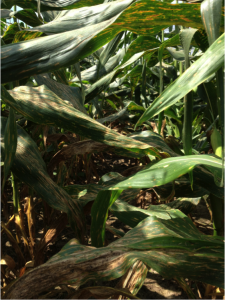
Fact Sheets And Publications
Gray Leaf Spot on Corn
Gray leaf spot, caused by the fungus Cercospora zeae maydis is the most significant yield-limiting disease of corn worldwide [1]. The disease was first reported in Illinois in 1924, and has increased in prevalence throughout corn growing regions since 1988. It is believed that an increase in no-till and conservation tillage farming has contributed to the increase of this disease [1]. Gray leaf spot is one of the most common foliar diseases in Delaware corn and can significantly reduce corn yields under favorable conditions. This article will discuss how to diagnose Gray leaf spot, the disease cycle of the pathogen, impacts of the disease, and management recommendations.

Disease Identification
Signs of Gray leaf spot are often first noticed on the lower leaves. Symptomatic leaves have small, tan, rectangular lesions surrounded with yellow halos, which are not easily distinguished from lesions caused by other foliar pathogens of corn. Mature lesions are much more diagnostic and easier to distinguish from other common foliar diseases; they are long, grey to tan in color, and rectangular (Figure 1). With time lesions can coalesce and form large necrotic areas and decimate the canopy (Figure 2). Lesion size and color can vary depending on the corn hybrid. Under some conditions lesions may occur on stalks [2]. These lesions are not rectangular but rather amorphous, with tan or gray centers.
Disease Cycle
C. zeae maydis overwinters on corn residue. In the late spring, following periods of high humidity, the fungus produces spores within residue. These spores are wind-dispersed to newly planted corn where they infect plant foliage and produce lesions.

Under favorable environmental conditions spores are produced on foliar lesions and spread to upper leaves and other plants. Several batches of spores from lesions can be produced during the growing season, resulting in severe epidemics [1, 2]. The majority of disease spread via spores occurs over a relatively short distance, but spores may escape the canopy and travel great distances.
Impacts of the Disease
Severe outbreaks of Gray leaf spot can result in losses resulting from reduced photosynthesis and grain fill [2]. In order to cause severe yield reduction the disease must damage leaves around the silking growth stage. Yield reductions are minimal if symptoms do not reach the ear leaf or if disease does not reach the ear leaf until grain fill. Other factors, such as hybrid susceptibility and favorable weather for pathogen infection greatly impact the impact of Gray leaf spot on corn production. There are currently no thresholds for Gray leaf spot although some researchers have developed general estimates of the disease on corn yield (Table 1).
| Percentage of leaf area affected by early dent stage (R5) | Approximate yield loss |
|---|---|
| <5% | 0-2% |
| 6-25% | 2-10% |
| 25%-75% | 5-20% |
| 75% - dead leaf | 15-50% |
Management
Effective management of Gray leaf spot involves the use of resistant hybrids, rotation with non-hosts, and residue management. In years where disease risk is high or growers have planted susceptible hybrids in no till fields, fungicides may be considered.
Resistant hybrids
It is essential that resistant varieties be used in fields with a history of Gray leaf spot, particularly in Delaware where the disease is endemic. There are numerous hybrids with resistance to this disease, although none are immune. Lesions on resistant hybrids are smaller and the disease develops more slowly than on susceptible hybrids [3, 4]. Scores for Gray leaf spot resistance are available from seed companies and dealers. Companies use different scales for rating resistance, so be sure to check the scale.
Cultural Practices
Growers who manage residue may still be at risk of disease spreading from surrounding fields because of the widespread use of no-till and conservation tillage in Delaware [5]. Cultural practices reduce local levels of inoculum, which may help reduce disease progress and impact on yield.
Rotation with Non-hosts
Gray leaf spot overwinters on corn residue and can be especially problematic in corn planted behind corn. The fungus does not grow well on non-host residues. Rotating away from corn may help reduce local levels of inoculum and reduce Gray leaf spot severity in the following corn crop. Several years out of corn may be required in no-till situations.
Residue Management
C. zeae maydis can survive on corn residue for one to two years. Practices that promote the decomposition of corn residue will greatly reduce the amount of the fungus present to cause disease [6]. Burying residue as little as 10-cm below the surface can greatly reduce primary infection levels.
Chemical Controls
There are numerous fungicides available for control of Gray leaf spot. However, there is no guarantee that fungicide applications will result in economic returns, especially if they are applied to highly resistant hybrids in fields with little disease. For this reason it is important to scout fields for symptoms of Gray leaf spot and apply fungicides only when they are needed. Scouts should pay particular attention to the lower three leaves of the corn plant from the period just before tasseling to two weeks after tasseling. If at least 50% of plants in a field have disease present on the third leaf below the ear leaf or higher prior to tasseling, the hybrid is susceptible, and the conditions are favorable for disease, then a spray may be warranted. Gray leaf spot severity is unpredictable and multiple factors should be considered when making the decision to use fungicides to control Gray leaf spot. Always follow label directions when applying a fungicide.
References
- Ward, J.M.J., et al., Gray leaf spot - A disease of global importance in maize production. Plant Disease, 1999. 83(10): p. 884-895.
- Lipps, P.E., Gray Leaf Spot: A global threat to corn production, in APSnet Features. 1998, American Phytopathological Society: http://www.apsnet.org/publications/apsnetfeatures/Pages/GrayLeafSpot.aspx.
- Bubeck, D.M., et al., Quantitative trait loci controlling resistance to gray leaf spot in maize. Crop Science, 1993. 33(4): p. 838-847.
- Coates, S.T. and D.G. White, Sources of resistance to gray leaf spot of corn. Plant Disease, 1994. 78(12): p. 1153-1155.
- Ringer, C.E. and A.P. Grybauskas, Infection cycle components and disease progress of gray leaf spot on field corn. Plant Disease, 1995. 79(1): p. 24-28.
- Denazareno, N.R.X., P.E. Lipps, and L.V. Madden, Effect of levels of corn residue on the epidemiology of gray leaf spot of corn in Ohio. Plant Disease, 1993. 77(1): p. 67-70.
UD Cooperative Extension
This institution is an equal opportunity provider.
In accordance with Federal law and U.S. Department of Agriculture policy, Cooperative Extension is prohibited from discriminating on the basis of race, color, national origin, sex, age, or disability.
